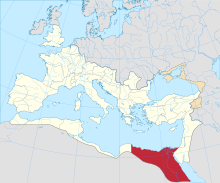
Back Aegyptus (Romeinse provinsie) AF مصر (مقاطعة رومانية) Arabic Рымскі Егіпет BE Египет (римска провинция) Bulgarian Egipte (província romana) Catalan Aegyptus Czech Ægyptus CY Aegyptus Danish Aegyptus German Ρωμαϊκή Αίγυπτος Greek
| Province of Egypt | |||||||||||
|---|---|---|---|---|---|---|---|---|---|---|---|
| Province of the Roman Empire | |||||||||||
| 30 BC – 641 AD Under Palmyrene rule; 270–273Sasanian occupation; 619–628 | |||||||||||
 Province of Aegyptus in AD 125 | |||||||||||
| Capital | Alexandria | ||||||||||
| Population | |||||||||||
• 1st century AD | 4 to 8 million.[1] | ||||||||||
| Historical era | Classical antiquity Late antiquity | ||||||||||
• Conquest of Ptolemaic Kingdom | 30 BC | ||||||||||
• Formation of the Diocese | 390 | ||||||||||
| 641 | |||||||||||
| |||||||||||
| Today part of | Egypt | ||||||||||
| History of Egypt |
|---|
 |
|
|
Roman Egypt[note 1] was an imperial province of the Roman Empire from 30 BC to AD 641. The province encompassed most of modern-day Egypt except for the Sinai. It was bordered by the provinces of Crete and Cyrenaica to the west and Judaea, later Arabia Petraea, to the East.
Egypt was conquered by Roman forces in 30 BC and became a province of the new Roman Empire upon its formation in 27 BC. Egypt came to serve as a major producer of grain for the empire and had a highly developed urban economy. It was by far the wealthiest Roman province outside of Italy.[2] The population of Roman Egypt is unknown, although estimates vary from 4 to 8 million.[3][1] Alexandria, its capital, was the largest port and second largest city of the Roman Empire.[4][5]
Three Roman legions garrisoned Egypt in the early Roman imperial period, with the garrison later reduced to two, alongside auxilia formations of the Roman army.[6] The major town of each nome (administrative region) was known as a metropolis[note 2] and granted additional privileges.[6] The inhabitants of Roman Egypt were divided by social class along ethnic and cultural lines.[6] Most inhabitants were peasant farmers, who lived in rural villages and spoke the Egyptian language (which evolved from the Demotic Egyptian of the Late and Ptolemaic periods to Coptic under Roman rule). In each metropolis, the citizens spoke Koine Greek and followed a Hellenistic culture. However there was considerable social mobility, increasing urbanization, and both the rural and urban population were involved in trade and had high literacy rates.[6] In AD 212, the Constitutio Antoniniana gave Roman citizenship to all free Egyptians.[6]
The Antonine Plague struck in the late 2nd century, but Roman Egypt recovered by the 3rd century.[6] Having escaped much of the Crisis of the Third Century, Roman Egypt fell under the control of the breakaway Palmyrene Empire after an invasion of Egypt by Zenobia in 269.[7] The emperor Aurelian (r. 270–275) successfully besieged Alexandria and recovered Egypt. The usurpers Domitius Domitianus and Achilleus took control of the province in opposition to emperor Diocletian (r. 284–305), who recovered it in 297–298.[7] Diocletian then introduced administrative and economic reforms. These coincided with the Christianization of the Roman Empire, especially the growth of Christianity in Egypt.[7] After Constantine the Great gained control of Egypt in AD 324, the emperors promoted Christianity.[7] The Coptic language, derived from earlier forms of Egyptian, emerged among the Christians of Roman Egypt.[6]
Under Diocletian the frontier was moved downriver to the First Cataract of the Nile at Syene (Aswan), withdrawing from the Dodekaschoinos region.[7] This southern frontier was largely peaceful for many centuries,[7] likely garrisoned by limitanei of the late Roman army. Regular units also served in Egypt, including Scythians known to have been stationed in the Thebaid by Justinian the Great (r. 527–565). Constantine introduced the gold solidus coin, which stabilized the economy.[7] The trend towards private ownership of land became more pronounced in the 5th century and peaked in the 6th century, with large estates built up from many individual plots.[7] Some large estates were owned by Christian churches, and smaller land-holders included those who were themselves both tenant farmers on larger estates and landlords of tenant-farmers working their own land.[7] The First Plague Pandemic arrived in the Mediterranean Basin with the emergence of the Justinianic Plague at Pelusium in Roman Egypt in 541.
Egypt was conquered by the Sasanian Empire in 618, who ruled the territory for a decade, but it was returned to the Eastern Roman Empire by the defection of the governor in 628. Egypt permanently ceased to be a part of the Roman Empire in 641, when it became part of the Rashidun Caliphate following the Muslim conquest of Egypt.
- ^ a b Janzen, Mark (2017). "Ancient Egypt Population Estimates: Slaves and Citizens". TheTorah.com. Retrieved 18 August 2019.
- ^ Maddison, Angus (2007), Contours of the World Economy, 1–2030 AD: Essays in Macro-Economic History, p. 55, table 1.14, Oxford University Press, ISBN 978-0-19-922721-1
- ^ Alan, Bowman (24 May 2012). "11 Ptolemaic and Roman Egypt: Population and Settlement'". academic.oup.com. pp. 317–358. Retrieved 2023-10-18.
- ^ Popkin, M. (2022), Souvenirs and the Experience of Empire in Ancient Rome, Cambridge University Press, p61
- ^ Reinhold, M. (2002), Studies in Classical History and Society, Oxford University Press, p36
- ^ a b c d e f g Cite error: The named reference
:0was invoked but never defined (see the help page). - ^ a b c d e f g h i Keenan, James (2018), Nicholson, Oliver (ed.), "Egypt", The Oxford Dictionary of Late Antiquity (online ed.), Oxford University Press, doi:10.1093/acref/9780198662778.001.0001, ISBN 978-0-19-866277-8, retrieved 2020-12-30
Cite error: There are <ref group=note> tags on this page, but the references will not show without a {{reflist|group=note}} template (see the help page).